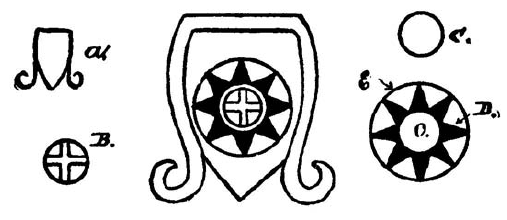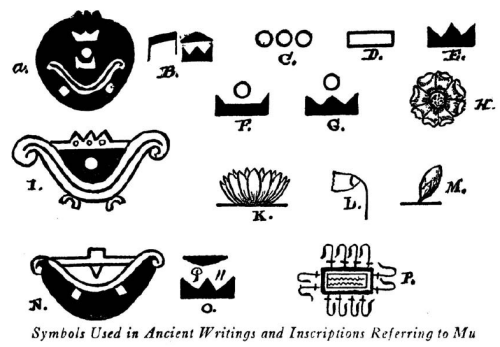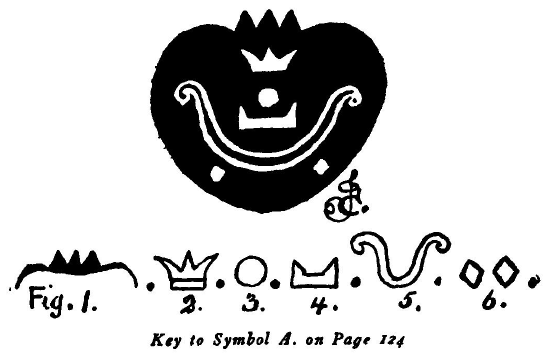|
CHAPTER VI
MU, THE EMPIRE OF THE SUN
MANY students of antiquity have noted the fact that ancient kings
and emperors assumed the title, "Son of the Sun." They have,
however, entirely failed to give the reason for these monarchs
assuming the title, except that in many instances it is asserted
they claimed to be sons of the celestial orb.
To find the actual reason for the assumption of this title we must
go back to the earth's first empire or kingdom, the Empire of the
Sun. This empire was formed in the Motherland of Man, and a royal
emblem or escutcheon was devised for it.

The Royal Escutcheon of MU
The Royal Escutcheon of Mu, the Empire of the Sun, was in no way a
haphazard device, for every line in it has a particular meaning, as
the deciphering and translation prove:
A. The form of the shield in a conventional letter M, one of the
letters in Mu's hieratic alphabet. It was her symbolical letter;
besides, the letter was her actual name, as the letter M was
pronounced Mu and Moo in the language of Mu.
B. This hieroglyphic is the central figure in the escutcheon and
reads: U-luumil - pronounced Oo-loo-oom-il, which, translated, is:
"The Empire of - "
C. The circle enclosing the glyph is a picture of the sun, so that
this compound glyph reads: "The Empire of the Sun." Then prefix the
shield and it is: "Mu, the Empire of the Sun."
D. The sun has eight rays, symbolizing the eight cardinal points,
thus saying that the whole earth was dominated by her.
E. The circle enclosing the rays is a symbol of the universe. This
universe as applied to man - man's universe, the earth. It is thus
shown again that her rays, her influence, fall on all mankind. Thus,
the Royal Escutcheon of Mu tells us that all mankind on earth was
under her rule. Mu was mistress of the whole earth, and this is
confirmed by the Codex Cortesianus, where Mu is referred to as The
Ruler.
Traditions say that when Mu was turned into an empire the Hieratic
Head was selected to be the king or emperor.
The Hieratic Head
represented the Deity in religious teachings. The sun, called Ra,
was the collective and highest symbol of the Deity. The sun was,
therefore, the symbol of "the King of Kings."
When elected to be the king, the Hieratic Head assumed the title of
Ra - the sun - Ra being the king's symbol. To this title was added
the name of the land Mu, so that the king's full title was Ra Mu, or
Sun Mu.
Then a new name was added to the land and it was called The Empire
of the Sun.
When the Empire of the Sun began is unknown. Empires and kingdoms
which were under her suzerainty are traced back for more than 35,000
years, so that the commencement of the Empire of the Sun antedates
35,000 years ago by a long time; how long no one can say. It might
have been only a thousand years and again it might have been tens of
thousands of years. Nothing in the shape of an old record, writing
or tradition has ever turned up to give us the slightest clue on
this point.
Apparently, as the various colonies of the Motherland became large
and sufficiently able to govern themselves, they were turned into
empires or kingdoms, but under the control of the Motherland, so
that the whole world was a great family under one control.
When a colony was turned into a kingdom or empire, the first king
was one of the royal family of the Motherland, or possibly, in some
instances, an appointee. When appointed, the new king assumed the
title of Son of the Sun. This was not intended to imply that he was
the Son of the celestial orb, but the Son of the Sun Dynasty of the
Empire of the Sun, or Son of the Empire of the Sun.
The emblem of the new king was still the sun, but in order to show
that he was a subject of the Motherland, or a part of it, only
one-half of the orb was shown above the horizon, with rays ascending
from it.
Valmiki, the ancient Hindu historian, speaking of the works of the
Mayas in India, says: "Before the sun rose above the horizon,"
meaning before the Hindu colony was turned into an empire.
When the Maya colony of the Deccan, India, was turned into a
kingdom, the first king was called Ra Ma. His emblem was the rising
sun, with only one-half of it showing above the horizon. He assumed
the title Son of the Sun.
The present Maharajah of Udipoor is said to be a direct descendant
of Ra Ma. If so, his forefathers were kings more than 30,000 years
ago. Unquestionably his is the oldest royal family on earth.
The rising sun is the emblem of various nations today, among them
being the Japanese, the Persians and some of the Central American
republics.
To differentiate between the rising and the setting sun, the
ancients were accustomed to depict the former with rays and the
latter as a plain disc or orb without rays.
After the Empire of the Sun came to its untimely end, the sun
whenever shown in connection with the Motherland always appears as
the setting sun.
SYMBOLS REPRESENTING MU USED IN ANCIENT WRITINGS

A. Is a Maya vignette, telling of the submersion of Mu, the Lands of
the West.

Deciphering and Translation
Fig. 1. The three points on the top of
the glyph are Mu's symbolical numeral, therefore the writings below
refer to Mu.
Fig. 2. The three-pointed crown is the Imperial crown of Mu - the
Empire of the Sun.
Fig. 3. The sun without rays, therefore Mu is in the region of
darkness.
Fig. 4. This symbol shows Mu submerged and in darkness, "peaks or
points only appear."
Fig. 5. This is the ancient symbol for an abyss, tank or depth.
Fig. 6. These symbolize the other two Lands of the West which were
carried with Mu down into the "tank of fire."
Free Reading
"Mu, the Empire of the Sun, has fallen into an abyss;
she is in the region of darkness, where the sun never shines upon
her. The other Lands of the West were blotted out with her. Her
crown no longer rules the earth."
The form of the hieroglyphic
itself is a conventional abyss.
B. Is hieratic writing reading, "Mu, Lands of the West."
C. Is the Motherland's numeral, three - assigned to Mu as her
numeral symbol.
D. Is the hieratic letter M of the Motherland's alphabet. It is also
a geometrical figure. It was Mu's symbol, both alphabetical and
geometrical.
E. Is a three-pointed geometrical figure, and was the
symbol used for Mu, showing her geographical position.
F.
Is a symbol for Mu after her submersion.
G. Is the same.
Sometimes one is used, sometimes the other.
H. Is the lotus flower in conventional form, the floral symbol for Mu.
I. Is a Maya vignette telling of the submersion of the Lands of the
West.
K. Is another form of the lotus symbolizing Mu.
L. Is the lotus, closed and dead, symbolizing that Mu no longer
exists.
M. Is a lotus bud, used as ornamentation.
N. Is a Maya vignette telling of the submersion of the land of Kui.
O. Is hieratic writing reading, "Land of Kui."
P. Is an Egyptian vignette symbolizing the destruction of Mu.
Back to Contents
|


